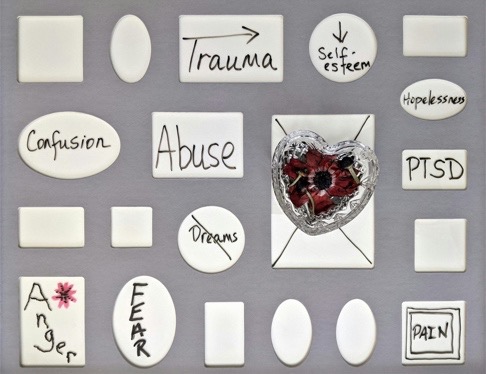I love to teach language learners how to write, from grammar and sentence structure to unity, clarity, and cohesion. As they advance, I ask them to check for rhythm and pacing, delete redundancies, and charge their writing with words that pop from the page into their readers’ imaginations. I show them how to carefully craft their sentences to persuade their audiences. Nothing makes me happier than to see these elements emerge in my students’ papers.
Continue readingAll posts by Jennifer Hutchison
Engaging students through art
I have zero talent in drawing or painting. My students giggle as I sketch something on the whiteboard, be it a cat, house, fork, whatever. I channel my creativity in other ways. In online classes, for example, I add artistic flourishes to my class presentations by using colourful and playful designs and animations. And since my students seem to like it, I thought, why not use more visual art to teach the course content?
Continue readingMy shift to word chunks
Session after session, I integrate a “word of the day” into my lessons for students to add to their notebooks. I explain what the word means, provide examples of its use, and task them with using it that day. But I recently wondered whether it would be better to teach a “lexical chunk of the day” instead, as they tend to have a greater impact than isolated words. Also, students gravitate to these fixed expressions and are always asking what they mean. Indeed, well-known language educator Scott Thornbury supports this approach in Chunk-Spotting–A User’s Guide: “the possession of a memorized store of chunks allows more rapid processing, not only for production but also for reception. It’s quicker to process several words at a time rather than each word individually.”
Continue readingSharing Languages, Sharing Realities
As I scrambled to find an idea for today’s post, I mused about my classes over the last couple of weeks. Had any stood out in terms of student engagement? The answer hit me: our discussions on how language affects the way we see the world. Indeed, before we knew it, we had ventured into linguistic relativity, or the Sapir-Whorf hypothesis. These discussions sprang from our “Language and Culture” unit, specifically a TED Talk by Lindsay Morcom, Associate Professor and Canada Research Chair in Language Revitalization and Decolonizing Education at Queen’s University.
Continue readingMitigating the Effects of Trauma

“Two of my brothers were killed in the war in Ukraine.”
“My family’s houses were destroyed in Palestine”
“I have PTSD from a trauma in my homeland.”
“There is fighting in my street back home, and I can’t reach anyone.”
“My mother was sent to a re-education centre for being a Uyghur.”
“My husband and I and our two sons were put on a kill list, so we had to flee my country.”
“My sister is sick, and I cannot go back and see her before she dies.”
Continue readingThe Power of Storytelling
Everyone loves a good story. For generations, people of all ages and backgrounds have entertained one other with their exploits and adventures, sometimes fanciful, sometimes not. Stories can be told over dinner, sung in a song, enacted on stage, painted on canvas, or printed in a book. They can be long, short, sad, uplifting, serious or funny. You don’t need much to create a story, other than a couple of ideas and a voice or pen and paper. And yet, for such a simple tool, its benefits are prolific.
Continue readingMoving beyond the shadows: Showcasing AI in the classroom

In my last blog post, I mentioned the hours I had spent examining students’ work for suspected AI use. Now, a couple of months later, I am more exhausted from the process than ever. We educators are still muddling our way through without clear policies or reliable detection tools, and are literally left “up to our own devices.”
But what if we change tack? What if we encourage students to use AI? Until now, I have balked at exploring its use in class, worried about introducing it to students who had never heard of it. After all, what kind of teacher would show students how to cheat? But I am no longer under such delusions. Unless they have been hiding under a rock, most students know exactly how to use AI tools.
Continue readingMarking my life away

I set the timer and focus on my new goal: to grade a paper in twenty minutes. Everything starts smoothly; checkmark after checkmark, praise after praise. A quick glance at the rest of the paper reveals more of the same error-free, polished style. Hmm. I pull up the student’s writing diagnostic, previous assignments, and emails. All are riddled with errors and awkward phrasing. The plagiarism report, though, comes up clean.
Continue readingFirst Day Back

As the streetcar lurched toward George Brown College, I gazed at the familiar storefronts, churches, and coffee shops that lined the route. How could everything be the same when it felt so different? I was nervous, panicked even. After all, I hadn’t taught in-person for close to three years. I berated myself for checking off the box to teach on campus. Wasn’t it easier to stay enclosed in my basement lair? I rechecked the supplies in my backpack and pulled out the instructions sheet for the tenth time. Offices have moved here, photocopiers are now there; do this if you need to print something, do that to access the computer system. Ughh.
Continue readingHow much technology is too much?
I have taught exclusively online for two and half years. During this time, the number of digital tools in my arsenal has skyrocketed. I have been consumed by technology. I used to feel sorry for “computer nerds” who squirrelled away in their basements, rarely coming up for air. And now I am one of them.
Continue reading





